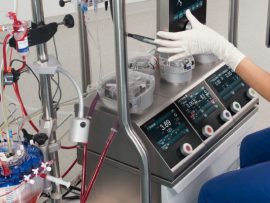Abstract Objectives: Extracorporeal membrane oxygenation (ECMO) is a critical intervention for patients with severe cardiac or respiratory failure. However, pharmacological management for ECMO-supported patients presents unique challenges due to alterations..
Read MoreAbstract Background: Population pharmacokinetics (PK) models could provide specific references for the formulation of personal drug delivery protocols, however, there is no population PK study of tranexamic acid (TXA) have been..
Read MoreAbstract Cardiopulmonary bypass (CPB) impacts pharmacokinetics and -dynamics of drugs used during cardiac surgery. These alterations can lead to changes in drug efficacy resulting in under- or overdosing. This review..
Read MoreAbstract Background: In cardiac surgery, protamine is used to reverse the effects of heparin after separation from cardiopulmonary bypass (CPB). Excess of protamine has been demonstrated to cause platelet dysfunction and..
Read MoreAbstract Objectives Our objective was to explore the effects of extracorporeal membrane oxygenation (ECMO) on the pharmacokinetics of dexmedetomidine hydrochloride via vitro and in vivo experiments Design A single-center animal..
Read MoreAbstract Purpose Tranexamic acid (TXA) is widely used as an antifibrinolytic drug. However, studies to determine the optimal blood concentration of TXA have produced inconsistent results. During cardiac surgery, cardiopulmonary..
Read MoreAbstract Extracorporeal life support (ECLS), including extracorporeal membrane oxygenation (ECMO) and continuous renal replacement therapy (CRRT), is a lifesaving therapy for critically ill children. Despite this, these modalities carry frustratingly..
Read MoreAbstract Extracorporeal membrane oxygenation (ECMO) is a lifesaving treatment for critically ill patients in cardiac or respiratory failure refractory to conventional treatment. Patients on an ECMO circuit (pump, oxygenator, tubing)..
Read MoreAbstract Cardiopulmonary bypass (CPB) can alter pharmacokinetic (PK) parameters and the drug may adsorb to the CPB device, altering exposure. Cefazolin is a beta-lactam antibiotic used for antimicrobial prophylaxis during..
Read MoreAbstract Extracorporeal membrane oxygenation (ECMO) is an emerging treatment modality associated with a high frequency of antibiotic use. However, several covariables emerge during ECMO implementation, potentially jeopardizing the success of..
Read MoreAbstract Fentanyl is commonly used in critically ill patients receiving extracorporeal membrane oxygenation (ECMO). Fentanyl’s lipophilicity and protein binding may contribute to a sequestration of the drug in the ECMO..
Read MoreAbstract Extracorporeal membrane oxygenation (ECMO), which can support gas exchange or hemodynamics in patients with severe respiratory or cardiac failure, has demonstrated considerable evolution over the last decade [], with..
Read MoreAbstract Introduction This study aims to determine the oxygenator impact on alterations of peramivir (PRV) in a contemporary neonatal/pediatric (1/4-inch) and adolescent/adult (3/8-inch) extra-corporeal membrane oxygenation (ECMO) circuit including the..
Read MoreAbstract There is limited evidence as to the pharmacokinetic changes expected in adults with extracorporeal technologies. Drugs may be taken up by various components of the cardiopulmonary bypass circuit itself...
Read MoreAbstract There is limited evidence as to the pharmacokinetic changes expected in adults with extracorporeal technologies. Drugs may be taken up by various components of the cardiopulmonary bypass circuit itself...
Read MoreAbstract OBJECTIVE This study aims to describe the population pharmacokinetics and pharmacodynamic target attainment of meropenem in critically ill children. METHODS The study involved a retrospective medical record review from..
Read MoreAbstract Objective Adequate levels of perioperative antibiotic are essential for prevention of . We examined details of 2 g administered during with repeat dosing shortly after initiation of (CPB) in cardiac surgery. Methods To identify the microbiologic..
Read MoreAbstract Tranexamic acid reduces blood loss and transfusion requirements with no significant thrombotic adverse effects. Postoperative seizures have been seen in cardiac surgical patients in association with patient (advanced age,..
Read MoreAbstract Objectives Our aim was to describe the pharmacokinetics of cefazolin in paediatric patients undergoing cardiac surgery with cardiopulmonary bypass (CPB) who received cefazolin for peri-operative surgical prophylaxis in addition..
Read MoreAbstract Extracorporeal membrane oxygenation is a rapidly emerging treatment for respiratory or cardiac failure and is used as a bridge to recovery, transplant, or destination therapy. Adult patients receiving extracorporeal..
Read More












